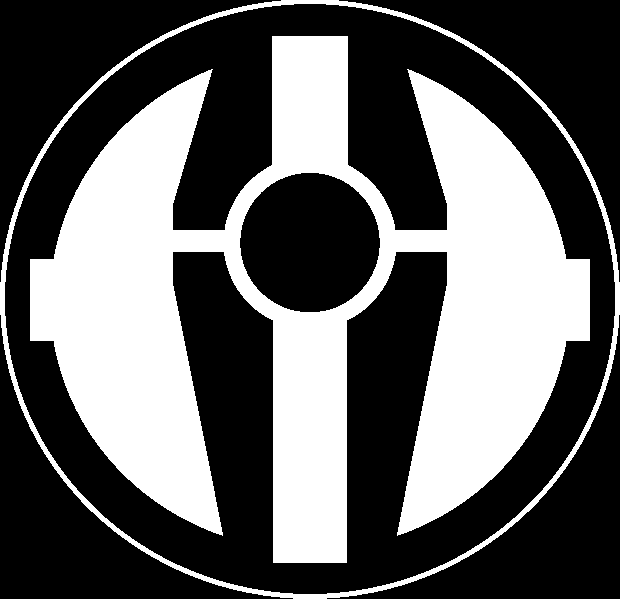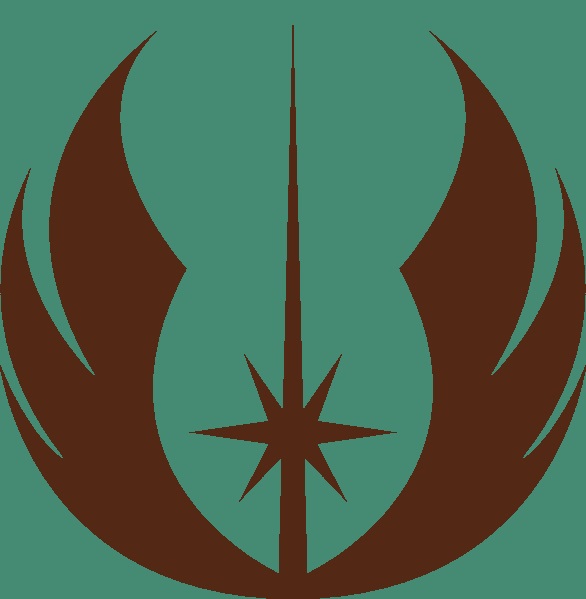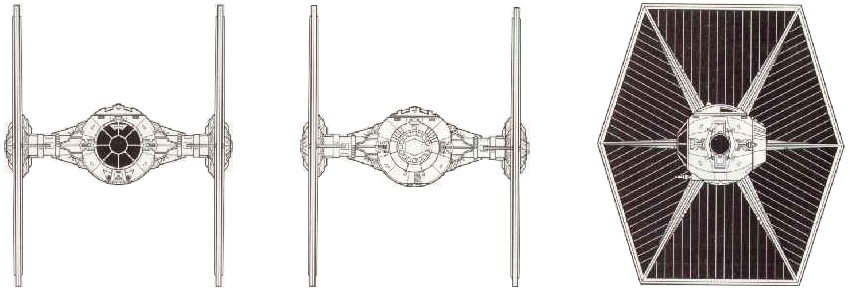| TIE/ln ("Line")Starfighter. |
|---|
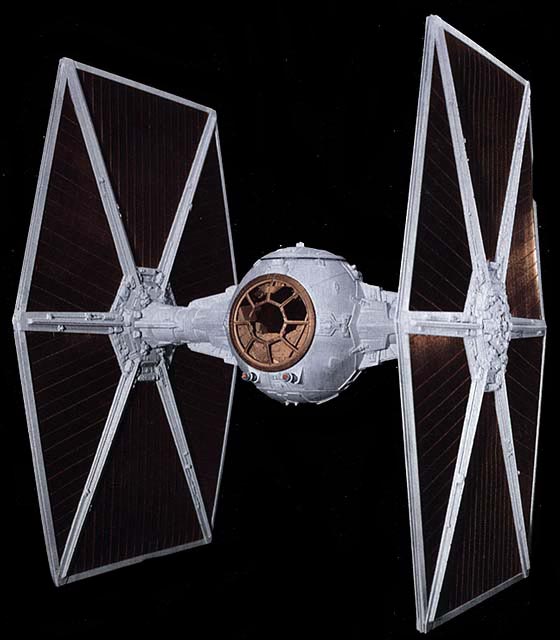 | | Production Information: |
|---|
| Manufacturer: | Sienar Fleet Systems. |
|---|
| Product Line: | TIE series. |
|---|
| Class: | Starfighter. |
|---|
| Technical Specifications: |
|---|
| Length: | 20 feet 11 inches (XXm). |
|---|
| Maximum Acceleration: | 4,100 G. |
|---|
| Megalight: | 100 MGLT. |
|---|
| Maximum Speed (atmosphere): | 746 mph (XXkph). |
|---|
| Engine Units: | SFS P-s5.6 Twin Ion Engines (rated 175 KTU);SFS P-w401 ion maneuvering jets (rated 150 KTU). |
|---|
| Powerplant: | SFS I-a2b solar ionization reactor;Secondary generator for cannons. |
|---|
| Hull: | Titanium alloy hull (15 RU). |
|---|
| Sensor Systems: | SFS S-c3.8 multi-range TAG. |
|---|
| Targeting Systems: | SFS T-s8 targeting computer. |
|---|
| Avionics: | SFS F-3.2 flight avionics system. |
|---|
| Armament: | SFS L-s1 laser cannons (2). |
|---|
| Escape Craft: | Ejector seat. |
|---|
| Crew: | Standard: Pilot (1);Rebel Alliance Variant: Pilot (1) and Astromech droid (1). |
|---|
| Cargo Capacity: | 144 lbs (XX kilograms). |
|---|
| Consumables: | 2 days. |
|---|
| Communication Systems: | AE-35 subspace transceiver;Distress beacon. |
|---|
| Usage: |
|---|
| Role: | Multi-purpose space superiority fighter. |
|---|
| Introduced: | Bet. 19 BBY and 3 BBY. |
|---|
| Eras: | Rise of the Empire Era;Rebellion Era;New Republic Era;New Jedi Order Era;Legacy Era. |
|---|
| Affiliation: | Palpatinian (Galactic) Empire;Alliance to Restore the Republic (Rebel Alliance);Imperial Remnant;Galactic Federation of Free Alliances;Confederation;Various RDF'S;Various PMC's. |
|---|
"Sienar Systems' basic TIE Fighter- A commodity which, after
hydrogen and stupidity, was the most plentiful in the galaxy."- Geh 'Dia Master General Corran HORN on the TIE/ln, quoted in "I, Jedi" |
The TIE/ln starfighter or TIE/line, simply known as the TIE Fighter, was the standard Imperial starfighter seen in massive numbers throughout most of the Galactic Civil War and afterwards.Characteristics"The aging, outdated craft employed by the Rebels are no match for
the power of the TIE, and even the prototype T-65 X-Wing created
by the traitors who escaped from Incom is clearly outclassed."- Captain West REYNOLDS, quoted in "TIE Fighter: A Pocket Manual" |
The TIE fighter was the original design for later models; After the UGC Annexation of the Rakatan Galaxy, those were paired down to the TIE/ln Starfighter, TIE/ln Intereceptor, and the TIE/d Drone Fighter, for cost reasons. The design descended from starfighters developed 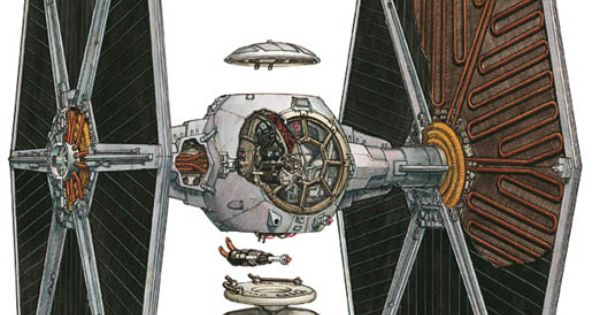 |
|---|
| Cut Away View. |
|---|
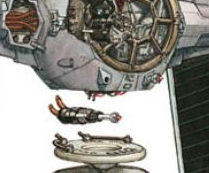 |
|---|
| Deatiled Cut Away View; Weapons Systems. All TIE Series craft have some varaition of this system. |
|---|
for the Galactic Republic and manufactured by Sienar Fleet Systems.PowerplantThe primary power plant is a pair of SFS I-a2b Solar Ionization Reactors, which appear as huge flat panels, like lateral wings. A secondary generator just for the cannons was also installed. The side view of a TIE/ln's radiator panels curiously resembles the emblem of the Confederacy of Independent Systems, but it is not clear if the similarity was intentional.PropulsionThe name "TIE" implies the propulsion system: It stands for "Twin Ion Engine", and literally reflects the engines fo the TIE. 02 ion engines, most recently the Seinar Fleet System's P-s5.6, an upgraded version of the SFS P-s4 twin ion engine used aboard TIE/ln starfighters, rated at 175 KTU. They are one of the most precisely manufactured propulsion systems in the galaxy and, with no moving parts, was low-maintenance. The lack of combat shields, hyperdrive, and life-support systems, in concert with the advanced engine design, reduced the mass of the fighter and conferred exceptional maneuverability. The only disadvantage is that they require electricity to work; This is the reason for the large solar panels on either side.ArmamentPrimary armament was a pair of laser cannons. These cannons were relatively powerful, and a well-placed hit on a starfighter or medium transport could damage or destroy it. It did not carry missile tubes, but such weapons could be added on if necessary.Survival SystemsDue to the lack of life-support systems, each TIE pilot had a fully-sealed flight suit superior to most of their enemies. The absence of a hyperdrive also rendered the fighter totally dependent on carrier ships when deployed in enemy systems. TIE/lns also lacked landing gear, another mass-reducing measure. While the ships were structurally capable of "sitting" on their wings, they were not designed to land or disembark their pilots without special support. On Imperial ships, TIEs were launched from racks in the hangar bays.TacticsTIEs were designed to attack in large numbers, overwhelming the enemy craft. Standard attack squadrons consisted of 12 fighters while full attack wings were made up of six squadrons. The Imperials used so many that they came to be considered symbols of the Empire and its might. They were also very cheap to produce, reflecting the Imperial philosophy of quantity over quality.Contrary to popular belief, the ships did possess ejection seats, but the nature of space Warfare often resulted in pilots riding their craft down to a swift end rather than ejecting and risking slow death by heat loss and oxygen starvation in the vacuum of space.The design choices of the TIE/ln could arguably be explained by Imperial military philosophy, which viewed the starfighters and their pilots as an expendable asset. Though Imperial pilots were of an elite stock, they also considered themselves expendable, in accordance with their ideological training.A disadvantage of the fighter was its lack of deflector shields. In combat, pilots had to rely on the TIE/ln's maneuverability to avoid damage. The cockpit did incorporate crash webbing, a repulsorlift antigravity field, and a high-g shock seat to help protect the pilot, however these did next to nothing to help protect against enemy blaster fire. However, despite this lack of protection, the fighter was at least able to survive glancing hits.The front/rear cross-section of the fighter was designed to be small to make it difficult to hit with blasters, but these side panels proved easy targets for flanking enemy pilots. They also hampered the fighter's ability to maneuver while in the atmosphere. Due to their distinct shape, TIE/ln came to be referred to occasionally as "eyeballs" by enemy pilots.History"For every TIE fighter you shoot down,
a thousand more will take its place."- Baron Soontir FEL, quoted in "Essential Guide to Vehicles and Vessels" |
The basic TIE starfighter inspired a number of other Imperial starfighters manufactured by Sienar Fleet Systems, which became collectively known as the TIE series. The TIE Line fighter was one of them, and replaced the original model as the standard fleet fighter in the Empire. While the original TIE had performance parity with heavier-built X-wings, the newer TIE/ln boasted improved engines and more powerful weapons, surpassing contemporary Rebel fighters.TIEs would be used in massive numbers throughout the Galactic Civil War and would be regarded by many as a symbol of the Empire. Some TIEs fell into the hands of the Rebellion, who would sometimes use them to infiltrate Imperial facilities.It had been intended that the TIE/ln would be replaced by the TIE Interceptor, and indeed Interceptors began to see greater use around the time of the Battle of Endor, but the collapse of the Imperial government into sectionalism precluded this. As the Galactic Empire retreated, more and more factories found themselves behind New Republic lines and ceased production. The New Republic made limited use of captured TIEs, equipping them with shields and assigning them to sectors where they weren't considered a symbol of the Empire. Their most notable use in New Republic service was at the Battle of Adumar. Captured TIE fighters were also used for deceptive purposes, such as during the Mission on Prefsbelt IV.UGC ServiceCurrently the TIE is deployed as second-tier defensive platform by many systems, but not by the REF, nor will it be; They are outclassed by just about everything in the UGC's arsenal and the combined arsenals of every other empire the UGC has annexed, with the possible exception of other tertiary fighters.There were proposals to convert the entire TIE/ln fleet to TIE/D, but the cost was overwhelming, and TIE/D's are, to be perfectly blunt, seriously inferior (in a 10 on 1 dogfight against a Ghost fighter, the Ghost came home limping a bit, but not enough was left of the TIE/D to confirmably identify them AS TIE/D's.) There was another proposal to convert them to TIE/IN's, which the UGC fully funded until a target confirmation crisis arose (Palpatinain TIE/IN's looked too much like UGC- and un-affiliated TIE/IN's), which temporarily suspended that program (it was restarted months later when the issues were informally worked out). The UGC does NOT provide support for TIE/lns, but will provided support for conversions of TIE/lns to TIE/IN.Model and Number: TIE Interceptor.Vehicle Type: Space Superiority Fighter.Crew: One.M.D.C By Location: |
- E.S.M.: Radar Detector. Passively detects other radars being operated.
- Radar: Combat grade radar. Range 1,000 miles, can track up to 500 individual targets. 95% reliability (24% against unfriendly stealthed vehicles).
- Blue Force Tracker: Identifies friend from foe. Overlays the information on both the radar and HUD, ensuring that friendly forces are not accidentally targeted.
- HUD: Displays maps, radar, targeting information, and any OTHER information the wearer wants directly in front of the user.
- FLIR/SLIR: Forward and Side Looking Infrared. Allows pilot to get visuals on targets at night.
- Oxygen Rebreather System: Extends pilots air supply to 100 hours; Cartridge MUST be replaced after that period of time.
- Magnetic Clamps: Electro-magnets in the pads at the bottom of the wing pylons allow the fighter to adhere to the hulls of Warships and the exteriors of SOME buildings.
- Full Range Sensory Systems: Infrared, Ultra Violet, Color Filters, and Thermal Imager: Range: 10 miles; Magnification: 40 times
| - Type-11 Wide Band Radios: Effective 10 mile range, auto encrypt/decrypt. Works on standard radio band wavelengths, so it can still be jammed (if the enemy knows the frequencies).
- AJP: Active Jamming Pod. Causes -25% to detection but when it is active, other vehicles/bases can detect that it is jamming, and some missiles will home in on jamming signals. Jamming also causes a -4 penalty to all radar guided weapons. The jamming pod is only mounted inside the port taileron.
- Combat/Targeting Computer: Records all enemy and friendly activity over the course of time; Can replay that activity for the pilot, assign target designation numbers, etc. Displays this information as a pop up in the HUD on request by the pilot.
- Virtual Map: Displays a continuously-updating map of local terrain for the pilot. Takes data from and gives it to other friendly units in the area. Effective land navigation of 85% as updates come. Good to 500 miles. Specific range can be adjusted in 100 mile increments.
- Video Camera: Records from the HUD and HDD. 50 hours of recording available.
- Survival Pack: A pack of simpler emergency survival supplies.
|
